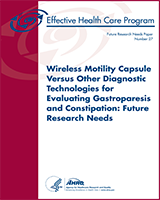NCBI Bookshelf. A service of the National Library of Medicine, National Institutes of Health.
Excerpt
The wireless motility capsule (WMC) is a new modality for diagnosing gastric and colonic motility disorders. The Johns Hopkins Evidence-based Practice Center recently completed an Agency for Healthcare Research and Quality (AHRQ)-funded systematic review of the effectiveness of WMC compared with other tests of gastric and colonic motility. We also sought to define populations that would benefit most from motility testing.
Overall, the strength of evidence regarding the ability of WMC to detect gastroparesis or slow-transit constipation was graded as low. The main limitations were inconsistencies in reporting the performance of motility testing modalities. Great variability existed in administering diagnostic tests and in assessing those tests. No uniform standards define differences in diagnostic accuracy, so we arbitrarily chose a 10 percent difference in sensitivity or specificity for reference standards, such as gastric scintigraphy, and device concordance for non-reference standards, such as radiopaque markers (ROM).
Most of the “normal” subjects upon which the tests were validated were college-age men, while most of the patients with suspected gastroparesis or constipation were women over the age of 50 years. Since the population of interest comprised motility patients, we excluded studies that included only nondiseased participants.
The major strength of the review was its comprehensiveness. We reviewed abstracts, queried industry sources for unpublished studies, and contacted study authors for missing data.
WMC is comparable to other modalities in use for detecting delayed gastric emptying and slow-transit constipation. Data are insufficient to determine the optimal timing of WMC in diagnostic algorithms.
The objectives of the Future Research Needs (FRN) project were to identify the evidence gaps highlighted by the results of the systematic review and to create a set of prioritized FRN to guide stakeholders in future decisions.
Contents
Prepared for: Agency for Healthcare Research and Quality, U.S. Department of Health and Human Services1, Contract No. 290-2007-10061-I. Prepared by: Johns Hopkins University Evidence-based Practice Center, Baltimore, MD
Suggested citation:
Stein E, Clarke JO, Hutfless S, Boult C, Doggett D, Fawole OA, Bass EB. Wireless Motility Capsule Versus Other Diagnostic Technologies for Evaluating Gastroparesis and Constipation: Future Research Needs. Future Research Needs Paper No. 27. (Prepared by the Johns Hopkins University Evidence-based Practice Center under Contract No. 290-2007-10061-I.) AHRQ Publication No. 13-EHC018-EF. Rockville, MD: Agency for Healthcare Research and Quality. May 2013. www.effectivehealthcare.ahrq.gov/reports/final.cfm.
This report is based on research conducted by the Johns Hopkins Evidence-based Practice Center (EPC) under contract to the Agency for Healthcare Research and Quality (AHRQ), Rockville, MD (Contract No. 290-2007-10061-I). The findings and conclusions in this document are those of the author(s), who are responsible for its contents; the findings and conclusions do not necessarily represent the views of AHRQ. Therefore, no statement in this report should be construed as an official position of AHRQ or of the U.S. Department of Health and Human Services.
The information in this report is intended to help health care researchers and funders of research make well-informed decisions in designing and funding research and thereby improve the quality of health care services. This report is not intended to be a substitute for the application of scientific judgment. Anyone who makes decisions concerning the provision of clinical care should consider this report in the same way as any medical research and in conjunction with all other pertinent information, i.e., in the context of available resources and circumstances.
None of the investigators have any affiliation or financial involvement that conflicts with the material presented in this report.
- 1
540 Gaither Road, Rockville, MD 20850; www
.ahrq.gov
